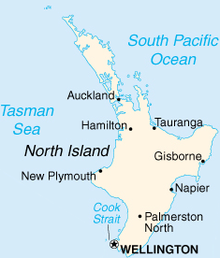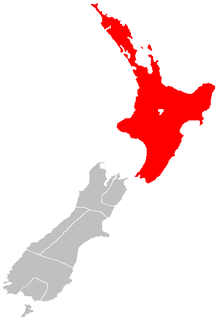North Island
 | |
| Geography | |
|---|---|
| Location | Oceania |
| Coordinates | 38°24′S 175°43′E / 38.400°S 175.717°E |
| Archipelago | New Zealand |
| Area | 113,729 km2 (43,911 sq mi) |
| Area rank | 14th |
| Highest elevation | 2,797 m (9177 ft) |
| Administration | |
New Zealand | |
| Demographics | |
| Population | 3,702,300 |
| Pop. density | 32.6/km2 (84.4/sq mi) |
The North Island (Māori: Te Ika-a-Māui) is one of the two main islands of New Zealand, separated from the slightly larger but much less populous South Island by Cook Strait. The island is 113,729 square kilometres (43,911 sq mi) in area,[1] making it the world's 14th-largest island. It has a population of 3,702,300 (June 2018).[2]
Twelve cities are in the North Island: Auckland, New Plymouth, Tauranga, Gisborne, Napier, Hamilton, Hastings, Palmerston North, Rotorua, Wanganui, Whangarei and Wellington, the capital, located at the southern extremity of the island. Approximately 76% of New Zealand's population lives in the North Island.
Naming and usage
Although the island has been known as the North Island for many years,[3] the New Zealand Geographic Board has found that, along with the South Island, it has no official name. The board intends to make North Island the island's official name, along with an alternative Māori name.[4] Although several Māori names have been used, Maori Language Commissioner Erima Henare sees Te Ika-a-Māui as the most likely choice.[5]
In prose, the two main islands of New Zealand are called the North Island and the South Island, with the definite articles. It is normal to use the preposition in rather than on, for example "Hamilton is in the North Island", "my mother lives in the North Island". Maps, headings, tables and adjectival expressions use North Island without the.
Māori mythology
According to Māori mythology, the North and South Islands of New Zealand arose through the actions of the demigod Māui. Māui and his brothers were fishing from their canoe (the South Island) when he caught a great fish and pulled it from the sea. While he was not looking his brothers fought over the fish and chopped it up. This great fish became the North Island and thus a Māori name for the North Island is Te Ika-a-Māui (The Fish of Māui). The mountains and valleys are believed to have been formed as a result of Māui's brothers' hacking at the fish. Until the early 20th Century, an alternative Māori name for the North Island was Aotearoa. In present Māori usage, Aotearoa is a collective name for New Zealand as a whole.
Economy
The sub-national GDP of the North Island was estimated at US$102.863 billion in 2003, 79% of New Zealand's national GDP.[6]
Ecology
The North Island has an extensive flora and bird population, with numerous National Parks and other protected areas.
Regions of the North Island
Nine local government regions cover the North Island and all its adjacent islands and territorial waters.
Cities and towns in the North Island
The North Island has a larger population than the South Island with both the country's largest city, Auckland as well as the capital, Wellington at either ends of the island.

| Cities and towns of the North Island by population | ||||||||||
|---|---|---|---|---|---|---|---|---|---|---|
| City/Town | Region | Population (2008) | City/Town | Region | Population (2008) | |||||
| 1 | Auckland | Auckland | 1,570,100 | 11 | Wanganui | Manawatu-Wanganui | 40,900 | |||
| 2 | Wellington | Wellington | 418,500 | 12 | Kapiti Coast | Wellington | 38,900 | |||
| 3 | Hamilton | Waikato | 241,200 | 13 | Gisborne | Gisborne | 31,100 | |||
| 4 | Tauranga | Bay Of Plenty | 141,600 | 14 | Taupo | Waikato | 22,600 | |||
| 5 | Palmerston North | Manawatu-Wanganui | 86,600 | 15 | Masterton | Wellington | 20,200 | |||
| 6 | Hastings | Hawke's Bay | 66,100 | 16 | Levin | Manawatu-Wanganui | 19,550 | |||
| 7 | Napier | Hawke's Bay | 58,400 | 17 | Whakatane | Bay Of Plenty | 18,700 | |||
| 8 | Rotorua | Bay Of Plenty | 59,500 | 18 | Cambridge | Waikato | 15,200 | |||
| 9 | New Plymouth | Taranaki | 58,300 | 19 | Feilding | Manawatu-Wanganui | 14,450 | |||
| 10 | Whangarei | Northland | 58,700 | 20 | Hawera | Taranaki | 11,100 | |||
Healthcare
Healthcare in the North Island is provided by fifteen District Health Boards (DHBs). Organized around geographical areas of varying population sizes, they are not coterminous with the Local Government Regions.
| Northland District Health Board (Te Poari Hauora a Rohe o te Tai Tokerau)
| Whangarei District, Far North District, Kaipara District
| 159,160
| Waitemata District Health Board (Te Wai Awhina) | North Shore City, Rodney District, Waitakere City | 525,000
| Auckland District Health Board (Te Toka Tumai) | Auckland City | 468,000
| Counties Manukau District Health Board (A Community Partnership) | Manukau City, Papakura District, Franklin District | 490,610
| Waikato District Health Board (Waikato DHB) | Hamilton City, Hauraki District, Matamata-Piako District, Otorohanga District, part of Ruapehu District, South Waikato, Thames-Coromandel District, Waikato District, Waipa District, Waitomo District | 372,865
| Bay of Plenty District Health Board (Hauora a Toi) | Tauranga City, Western Bay of Plenty District, Whakatane District, Kawerau District, Opotiki District | 214,170
| Lakes District Health Board (Lakes DHB) | Rotorua District, Taupo District | 102,000
| Tairawhiti District Health Board (Te Mana Hauora o te Tairawhiti) | Gisborne District | 44,499
| Hawke's Bay District Health Board (Whakawateatia) | Napier City, Hastings District, Wairoa District, Central Hawke's Bay District, Chatham Islands | 155,000
| Taranaki District Health Board (Taranaki DHB) | New Plymouth District, Stratford District, South Taranaki District | 104,280
| Whanganui District Health Board (Whanganui DHB) | Wanganui District, Rangitikei District, part of Ruapehu District | 62,210
| Mid Central District Health Board (Te Pae Hauora o Ruahine o Tararua) | Palmerston North City, Horowhenua District, Manawatu District, Tararua District, part of Kapiti Coast District | 158,838
| Wairarapa District Health Board (Te Poari Hauora a Rohe o Wairarapa) | South Wairarapa District, Carterton District, Masterton District | 38,200
| Hutt Valley District Health Board (Healthy People) | Lower Hutt City, Upper Hutt City | 145,000
| Capital and Coast District Health Board (Upoko ki te Uru Hauora) | Wellington City, Porirua City, part of Kapiti Coast District | 270,000
|-|}
Geographic features

- Cape Reinga
- East Cape
- Cape Palliser
- Hawke Bay
- Lake Taupo
- Mt Maunganui Beach
- Tongariro National Park
- Taumatawhakatangihangakoauauotamateapokaiwhenuakitanatahu
- Waikato River
- Waipoua Kauri Forest
- Waitomo Caves
- Ninety Mile Beach
See also
References
- ^ "Quick Facts - Land and Environment : Geography - Physical Features". Statistics New Zealand. 2000. Retrieved 13 August 2012.
- ^ "Subnational Population Estimates: At 30 June 2019". Statistics New Zealand. 22 October 2019. Retrieved 11 January 2020. For urban areas, "Subnational population estimates (UA, AU), by age and sex, at 30 June 1996, 2001, 2006–18 (2017 boundaries)". Statistics New Zealand. 23 October 2018. Retrieved 23 October 2018.
- ^ On some 19th-century maps, the North Island is named New Ulster, which was also a province of New Zealand that included the North Island.
- ^ "The New Zealand Geographic Board Considers North and South Island Names". Land Information New Zealand. 21 April 2009. Retrieved 28 November 2012.
- ^ Davison, Isaac (22 April 2009). "North and South Islands officially nameless". The New Zealand Herald. Retrieved 1 November 2011.
- ^ "Regional Gross Domestic Product". Statistics New Zealand. 2007. Retrieved 18 February 2010.
